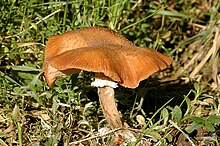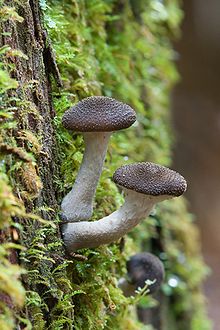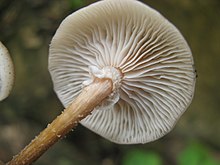
Armillaria is a genus of fungi that includes the A. mellea species known as honey fungi that live on trees and woody shrubs. It includes about 10 species formerly categorized summarily as A. mellea. Armillarias are long-lived and form the largest living fungi in the world. The largest known organism covers more than 3.4 square miles (8.8 km2) in Oregon's Malheur National Forest and is estimated to be 2,500 years old. Some species of Armillaria display bioluminescence, resulting in foxfire.

Armillaria mellea, commonly known as honey fungus, is an edible basidiomycete fungus in the genus Armillaria. It is a plant pathogen and part of a cryptic species complex of closely related and morphologically similar species. It causes Armillaria root rot in many plant species and produces mushrooms around the base of trees it has infected. The symptoms of infection appear in the crowns of infected trees as discoloured foliage, reduced growth, dieback of the branches and death. The mushrooms are edible but some people may be intolerant to them. This species is capable of producing light via bioluminescence in its mycelium.

Mycelial cords are linear aggregations of parallel-oriented hyphae. The mature cords are composed of wide, empty vessel hyphae surrounded by narrower sheathing hyphae. Cords may look similar to plant roots, and also frequently have similar functions; hence they are also called rhizomorphs. As well as growing underground or on the surface of trees and other plants, some fungi make mycelial cords which hang in the air from vegetation.

Armillaria luteobubalina, commonly known as the Australian honey fungus, is a species of mushroom in the family Physalacriaceae. Widely distributed in southern Australia, the fungus is responsible for a disease known as Armillaria root rot, a primary cause of Eucalyptus tree death and forest dieback. It is the most pathogenic and widespread of the six Armillaria species found in Australia. The fungus has also been collected in Argentina and Chile. Fruit bodies have cream- to tan-coloured caps that grow up to 10 cm (4 in) in diameter and stems that measure up to 20 cm (8 in) long by 1.5 cm (1 in) thick. The fruit bodies, which appear at the base of infected trees and other woody plants in autumn (March–April), are edible, but require cooking to remove the bitter taste. The fungus is dispersed through spores produced on gills on the underside of the caps, and also by growing vegetatively through the root systems of host trees. The ability of the fungus to spread vegetatively is facilitated by an aerating system that allows it to efficiently diffuse oxygen through rhizomorphs—rootlike structures made of dense masses of hyphae.
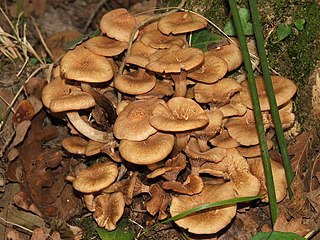
Armillaria tabescens is a species of fungus in the family Physalacriaceae. It is a plant pathogen. The mycelium of the fungus is bioluminescent.

Fistulinella is a genus of bolete fungi in the family Boletaceae. The genus has a pantropical distribution, and contains 15 species. Fistulinella was circumscribed by German mycologist Paul Christoph Hennings in 1901.

Armillaria novae-zelandiae is a species of mushroom-forming fungus in the family Physalacriaceae. This plant pathogen species is one of three Armillaria species that have been identified in New Zealand.

Armillaria limonea is a species of mushroom in the family Physalacriaceae. This plant pathogenic species is one of three Armillaria that have been identified in New Zealand.

Armillaria gallica is a species of honey mushroom in the family Physalacriaceae of the order Agaricales. The species is a common and ecologically important wood-decay fungus that can live as a saprobe, or as an opportunistic parasite in weakened tree hosts to cause root or butt rot. It is found in temperate regions of Asia, North America, and Europe. The species forms fruit bodies singly or in groups in soil or rotting wood. The fungus has been inadvertently introduced to South Africa. Armillaria gallica has had a confusing taxonomy, due in part to historical difficulties encountered in distinguishing between similar Armillaria species. The fungus received international attention in the early 1990s when an individual colony living in a Michigan forest was reported to cover an area of 15 hectares, weigh at least 9.5 tonnes, and be 1,500 years old. This individual is popularly known as the "humongous fungus", and is a tourist attraction and inspiration for an annual mushroom-themed festival in Crystal Falls. Recent studies have revised the fungus's age to 2,500 years and its size to about 400 tonnes, four times the original estimate.
Armillaria fellea is a species of mushroom in the family Physalacriaceae. This species is found in Australia.
Armillaria fumosa is a species of mushroom in the family Physalacriaceae. This species is found in Australia.
Armillaria griseomellea is a species of mushroom in the family Physalacriaceae. This species is found in South America.
Armillaria montagnei is a species of agaric fungus in the family Physalacriaceae. This species is found in Australia, Europe, New Zealand, and South America.
Armillaria pallidula is a species of mushroom in the family Physalacriaceae. This species is found in Australia.
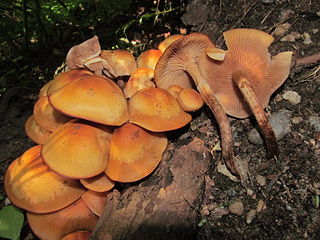
Armillaria nabsnona is a species of fungus in the family Physalacriaceae. The species is found in the west coast of North America, Hawaii, and Japan, where it grows on decaying hardwoods, particularly species of alder. Its fruit bodies have convex to flattened orange-brown caps up to 7 cm in diameter, brown stipes, and whitish to pinkish-tan gills.

Armillaria ostoyae is a species of fungus (mushroom), pathogenic to trees, in the family Physalacriaceae. In the western United States, it is the most common variant of the group of species under the name Armillaria mellea. A. ostoyae is common on both hardwood and conifer wood in forests west of the Cascade Range in Oregon, United States. It has decurrent gills and the stipe has a ring. The mycelium invades the sapwood and is able to disseminate over great distances under the bark or between trees in the form of black rhizomorphs ("shoestrings"). In most areas of North America, Armillaria ostoyae can be separated from other species by its physical features: cream-brown colors, prominent cap scales, and a well-developed stem ring distinguish it from other Armillaria. Like several other Armillaria, the mycelium of Armillaria ostoyae can display bioluminescence, resulting in foxfire.
Armillaria umbrinobrunnea is a species of mushroom in the family Physalacriaceae. This species is found in South America. The beige to light brown caps of the mushroom are between 15 and 50 mm in diameter, and densely covered in small scales. The species was originally collected in 1952 by Rolf Singer in Argentina, and named as the variety Armillariella montagnei var. umbrinobrunnea.
Roy Watling, PhD., DSc, FRSE, F.I.Biol., C.Biol., FLS is a Scottish mycologist who has made significant contributions to the study of fungi both in the identification of new species and correct taxonomic placement, as well as in fungal ecology.

